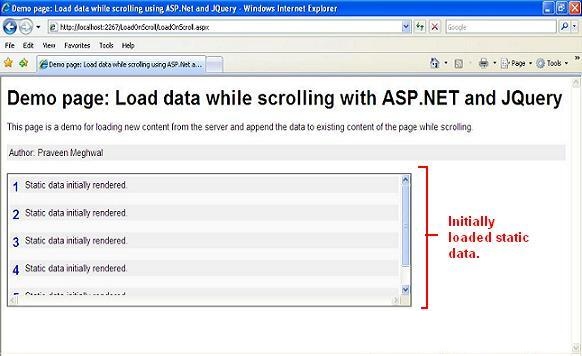Introduction
This article will demonstrate how to load data from the server while scrolling. Loading data from the server using AJX will help any application in improving its performance because
data which is displayed on the screen alone is loaded the first time and more data, if required, will get loaded from the server as the user scrolls.
Background
Facebook is the application which inspired me to write code to load data from the server while scrolling. While browsing Facebook, I was amazed to see that as I scrolled on the page,
new data from the server got appended to the existing one. I became curious about implementing the same functionality in C#. I searched for information, but did not find any article
or blog on doing this in C#. Of course, there were a few articles for Java and PHP. I read them carefully and started writing code in C#. As it worked successfully I thought
I'd share it, so I am posting it here.
The code
To implement the load on scroll functionality, we will require very few lines of code. A WebMethod that will be called from the client side which returns the content to append while scrolling,
and a client side function (document.ready) where we will bind the scroll event to load data from the server. Let us see these server and client side methods in detail.
Server method: This method is used to get data from the database or any source and prepares an HTML string
depending on the control you are using for appending data to. Here I have just added a message with the serial number.
[WebMethod]
public static string GetDataFromServer()
{
string resp = string.Empty;
for(int i = 0; i <= 10; i++)
{
resp += "<p><span>" + counter++ +
"</span> This content is dynamically appended " +
"to the existing content on scrolling.</p>" ;
}
return resp;
}
If you want to load data from database you can modify your method as follows :
[WebMethod]
public static string GetDataFromServer()
{
DataSet ds = new DataSet();
string strConnectionString = "";
SqlConnection con = new SqlConnection(strConnectionString);
SqlCommand command = new SqlCommand("SELECT * FROM Person", con);
SqlDataAdapter adp = new SqlDataAdapter(command);
int retVal = adp.Fill(ds);
string resp = string.Empty;
for (int i = 1; i <= ds.Tables[0].Rows.Count; i++)
{
string strComment = string.Empty;
if (ds.Tables != null)
{
if (ds.Tables[0] != null)
{
if (ds.Tables[0].Rows.Count > 0)
{
if (ds.Tables[0].Rows.Count >= i - 1)
{
if (ds.Tables[0].Rows[i - 1][0] != DBNull.Value)
{
strComment = ds.Tables[0].Rows[i - 1][0].ToString();
}
}
}
}
}
resp += "<p><span>" + counter++ + "</span> " + strComment + "</p>";
}
return resp;
}
Client method: At the client side, I have used the document.ready method in which I have registered event binding for scroll on div. I have used
two div elements: mainDiv and wrapperDiv. I have registered the scroll event for mainDiv and append dynamic data to wrapperDiv.
$(document).ready(
function()
{
$contentLoadTriggered = false;
$("#mainDiv").scroll(
function()
{
if($("#mainDiv").scrollTop() >= ($("#wrapperDiv").height() -
$("#mainDiv").height()) &&
$contentLoadTriggered == false)
$contentLoadTriggered == false)
{
$contentLoadTriggered = true;
$.ajax(
{
type: "POST",
url: "LoadOnScroll.aspx/GetDataFromServer",
data: "{}",
contentType: "application/json; charset=utf-8",
dataType: "json",
async: true,
cache: false,
success: function (msg)
{
$("#wrapperDiv").append(msg.d);
$contentLoadTriggered = false;
},
error: function (x, e)
{
alert("The call to the server side failed. " +
x.responseText);
}
}
);
}
}
);
}
);
Here, to check whether the scroller has moved at the bottom, the following condition is used.
if($("#mainDiv").scrollTop() >=
($("#wrapperDiv").height() - $("#mainDiv").height()) &&
$contentLoadTriggered == false)
This condition will identify whether the scroller has moved at the bottom or not. If it has moved at the bottom, dynamic data will get loaded from the server and get appended
to wrapperDiv. The client script to append data to the desired div element is written in the script to run when the asynchronous call results in success.
success: function (msg)
{
$("#wrapperDiv").append(msg.d);
$contentLoadTriggered = false;
}
Here one thing you will notice is that the request will go to the server only when the user has scrolled at the bottom.
I have attached the sample application with this article.
Output


History
First version.
